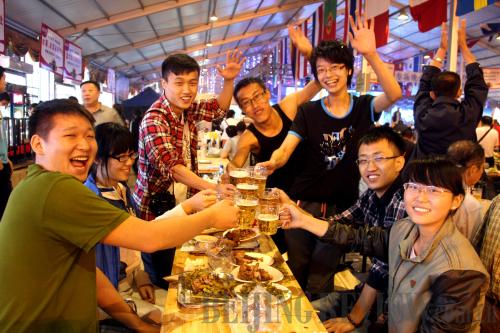|
 |
|
CHEERS: A group of friends toast during last year's Harbin International Beer Festival (CFP) |
Russia, redux
Western influence in the city, however, extends far beyond music. As a popular tourist destination, Harbin's Central Avenue bears the strong imprints of Russian culture. Walking into a boutique along the avenue, one can find a bevy of Russian handicrafts for sale including matryoshka dolls, chocolates and candies, and many varieties of vodka. Shops selling Russian sausages can be seen up and down the street. One would not be remiss in mistaking Central Avenue for a street in Russia.
The avenue is now the most prosperous commercial area in Harbin and has become a must-see tourist destination. During peak season, it receives as many as 1 million visitors per day. Buildings that represent a variety of architectural styles, from the Baroque period to Art Nouveau, line both sides of the street to form a veritable gallery of Western architecture trends.
In the early 20th century, Russians—along with merchants from many other European countries—set up banks, stores, hotels, cinemas and bars along Central Avenue. Thus, the street recreated the fashions and prosperity of Europe at that time. The Saint Sophia Cathedral, a Russian Orthodox church that stands to the east of the avenue, provides a marked contrast to the market's hustle and bustle.
"Harbin residents often come here not for the purpose of making any purchases, but simply to walk and relax," said Geng Wei, a local tour guide.
The street was paved in 1924 with pieces of granite shaped like small Russian breads. At that time, it is said, the value of just one such stone could feed a person for a month. Thus, the avenue was dubbed a "street paved with gold."
"On the one hand, Russians took advantage of many of the area's natural resources, but on the other, they left valuable legacies like the architecture in the city," said Geng.
Wide-reaching influence
Russia's mark upon the city is not only represented in such tangible forms as music and architecture, but pervades the lives of locals as well.
"The influence is everywhere," said Liu Qinggang, an official with the Harbin Municipal Tourism Bureau. "For example, Russian people founded a beer factory in the city in 1900, the first beer brewery in all of China. Today, people here have kept up the brewing tradition."
Since 1988, an annual beer festival has been held in Harbin each July. Drinking beer has become an important means for local people to socialize and negotiate business.
In addition to beverages, people in Harbin adopted their winter dress code from the Russians. In the worst of the cold, women wear thick fur coats, skirts and warm silk stockings.
"This way of dressing was first adopted from Russians and has been passed on through the present," said Liu.
Governor Lu noted, "Though the per-capita income of Harbin residents does not rank high, their per-capita fashion industry consumption has often ranked among the top three highest in the country."
Even the local love of picnics was adapted from Russian pastimes. On nice weekends, people spread out a sheet of cloth in one of the city's many parks and sit to enjoy food and beer with family and friends while feasting their eyes on the beautiful scenery.
"As summers in Harbin are very short, usually only two months long, people have to use the nice days for outdoor activities before the extremely cold winter returns," Yin Feng, a local citizen, told Beijing Review.
Despite the unforgiving climate, Harbin's distinct allure remains. "The city has offered me a unique taste of foreign culture," said Wang Xiaolin, a visitor to the city. "As a famous Chinese tourist city, Harbin showcases a variety of foreign cultures to Chinese and foreign tourists."
Email us at: jijing@bjreview.com | 